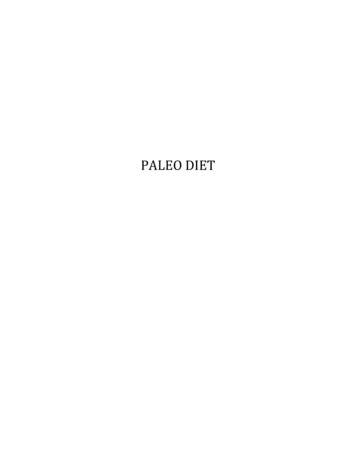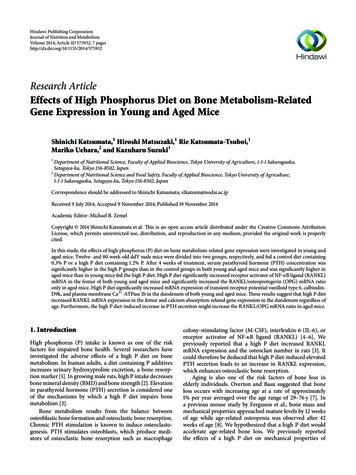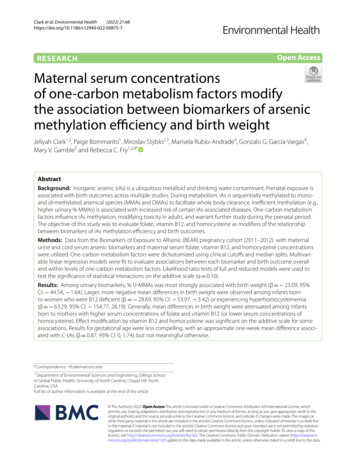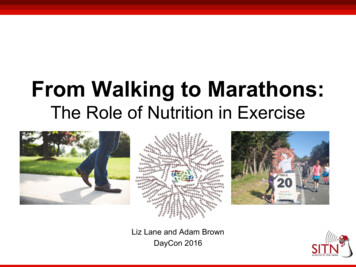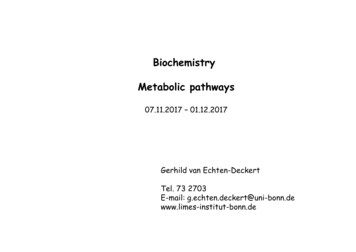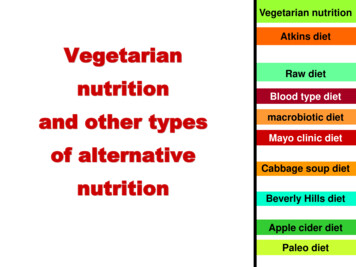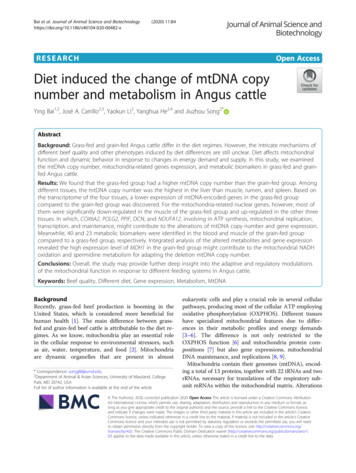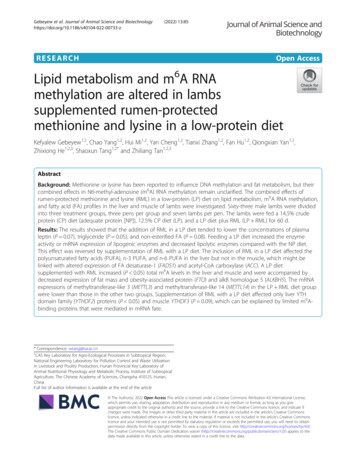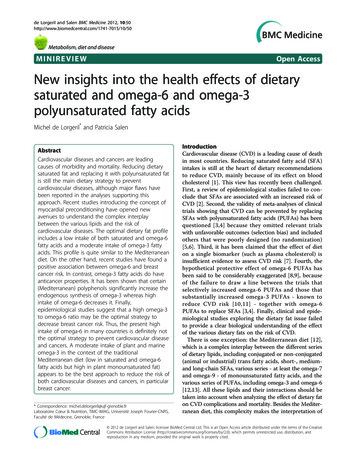
Transcription
de Lorgeril and Salen BMC Medicine 2012, etabolism, diet and diseaseMINIREVIEWOpen AccessNew insights into the health effects of dietarysaturated and omega-6 and omega-3polyunsaturated fatty acidsMichel de Lorgeril* and Patricia SalenAbstractCardiovascular diseases and cancers are leadingcauses of morbidity and mortality. Reducing dietarysaturated fat and replacing it with polyunsaturated fatis still the main dietary strategy to preventcardiovascular diseases, although major flaws havebeen reported in the analyses supporting thisapproach. Recent studies introducing the concept ofmyocardial preconditioning have opened newavenues to understand the complex interplaybetween the various lipids and the risk ofcardiovascular diseases. The optimal dietary fat profileincludes a low intake of both saturated and omega-6fatty acids and a moderate intake of omega-3 fattyacids. This profile is quite similar to the Mediterraneandiet. On the other hand, recent studies have found apositive association between omega-6 and breastcancer risk. In contrast, omega-3 fatty acids do haveanticancer properties. It has been shown that certain(Mediterranean) polyphenols significantly increase theendogenous synthesis of omega-3 whereas highintake of omega-6 decreases it. Finally,epidemiological studies suggest that a high omega-3to omega-6 ratio may be the optimal strategy todecrease breast cancer risk. Thus, the present highintake of omega-6 in many countries is definitely notthe optimal strategy to prevent cardiovascular diseaseand cancers. A moderate intake of plant and marineomega-3 in the context of the traditionalMediterranean diet (low in saturated and omega-6fatty acids but high in plant monounsaturated fat)appears to be the best approach to reduce the risk ofboth cardiovascular diseases and cancers, in particularbreast cancer.* Correspondence: michel.delorgeril@ujf-grenoble.frLaboratoire Cœur & Nutrition, TIMC-IMAG, Université Joseph Fourier-CNRS,Faculté de Médecine, Grenoble, FranceIntroductionCardiovascular disease (CVD) is a leading cause of deathin most countries. Reducing saturated fatty acid (SFA)intakes is still at the heart of dietary recommendationsto reduce CVD, mainly because of its effect on bloodcholesterol [1]. This view has recently been challenged.First, a review of epidemiological studies failed to conclude that SFAs are associated with an increased risk ofCVD [2]. Second, the validity of meta-analyses of clinicaltrials showing that CVD can be prevented by replacingSFAs with polyunsaturated fatty acids (PUFAs) has beenquestioned [3,4] because they omitted relevant trialswith unfavorable outcomes (selection bias) and includedothers that were poorly designed (no randomization)[5,6]. Third, it has been claimed that the effect of dieton a single biomarker (such as plasma cholesterol) isinsufficient evidence to assess CVD risk [7]. Fourth, thehypothetical protective effect of omega-6 PUFAs hasbeen said to be considerably exaggerated [8,9], becauseof the failure to draw a line between the trials thatselectively increased omega-6 PUFAs and those thatsubstantially increased omega-3 PUFAs - known toreduce CVD risk [10,11] - together with omega-6PUFAs to replace SFAs [3,4]. Finally, clinical and epidemiological studies exploring the dietary fat issue failedto provide a clear biological understanding of the effectof the various dietary fats on the risk of CVD.There is one exception: the Mediterranean diet [12],which is a complex interplay between the different seriesof dietary lipids, including conjugated or non-conjugated(animal or industrial) trans fatty acids, short-, mediumand long-chain SFAs, various series - at least the omega-7and omega-9 - of monounsaturated fatty acids, and thevarious series of PUFAs, including omega-3 and omega-6[12,13]. All these lipids and their interactions should betaken into account when analyzing the effect of dietary faton CVD complications and mortality. Besides the Mediterranean diet, this complexity makes the interpretation of 2012 de Lorgeril and Salen; licensee BioMed Central Ltd. This is an Open Access article distributed under the terms of the CreativeCommons Attribution License (http://creativecommons.org/licenses/by/2.0), which permits unrestricted use, distribution, andreproduction in any medium, provided the original work is properly cited.
de Lorgeril and Salen BMC Medicine 2012, age 2 of 5epidemiological data very difficult and explains the ceaseless controversy about dietary fats and the risk of CVD.However, recent studies in experimental nutrition usingthe concept of myocardial preconditioning [14] have provided new and critical insights into the biological effects ofdietary fat on CVD complications and mortality.These data should help identify the optimal dietaryfatty acid profile to reduce the risk and the complications of CVD. Thus, maintaining high [8] or increasing as proposed by certain experts [6,9] - the intake ofomega-6 in lieu of SFAs is definitely not the optimalstrategy to prevent CVD complications.Dietary fat, myocardial preconditioning andcardiovascular diseasePreconditioning - that is, the ability of the myocardium towithstand an ischemia-reperfusion injury - is a major concept in cardiology [14]. The extent of cell death duringand after myocardial ischemia is actually the primarydeterminant of the outcome of a heart attack. Ventriculararrhythmia and cardiac pump failure are among the mainclinical complications that are prevented by the initiationof myocardial preconditioning. Drug makers have failed toidentify pharmacological methods able to induce chronicpreconditioning [15]. In contrast, there are strong clinicaland experimental data suggesting that lifestyle - includingmoderate alcohol drinking and physical exercise - is apotent preconditioner [16,17]. Also, polyphenols presentin certain plants - and abundant in red wine - induce preconditioning [18]. Although obtained in experimental conditions, data regarding chronic myocardial preconditioningas induced by lifestyle and nutrition are highly consistentwith our general clinical knowledge regarding the effectsof lifestyle and nutrition on CVD complications and mortality. The next question is whether myocardial preconditioning could shed light on the role of dietary fat in CVD.In fact, two recent studies on rat models have providedmajor findings by comparing the effects of different dietaryfat profiles on the induction of myocardial preconditioning[19,20]. In both studies, the investigators compared theeffects of diets that were high in SFAs or omega-6 butpoor in omega-3 with diets that were poor in SFAs andomega-6 but rich in omega-3. In both studies, the bestprotection was obtained in the groups of rats receiving thediet high in omega-3 PUFAs but relatively poor in SFAsand omega-6 PUFAs, while the diet rich in omega-6 butrelatively poor in SFAs and omega-3 PUFAs provided noprotection [19] or a protection halfway between the dietsrich in SFAs, on one hand, and in omega-3, on the otherhand [20]. Thus, as compared with the common Westerndiet - rich in either SFAs or omega-6 PUFAs but poor inomega-3 PUFAs - an optimal dietary pattern aimed atreducing CVD complications and mortality should includea reduced intake of both SFAs and omega-6, in addition toincreased plant and marine omega-3 PUFAs. Not surprisingly, this dietary fatty acid profile is similar - but notidentical - to that of the Mediterranean diet, which also isrich in plant monounsaturated fat and poor in industrialtrans fatty acids [12,13].Dietary fat and cancerIn animal studies, omega-6 PUFAs have a strong mammary tumor-enhancing effect [21,22]. In order to exerttheir carcinogenic effects, they must first undergo anoxidative metabolization, mainly through the lipoxygenaseand cyclooxygenase pathways [23,24]. The main substrateof these oxidative pathways is arachidonic acid, which ismainly produced from dietary linoleic acid, the most common omega-6 PUFAs in Western foods and cooking fats.Several recent epidemiologic studies have found a positiveassociation between dietary omega-6 PUFAs and breastcancer risk [25-30]. Certain analyses took into account agenetic predisposition related to omega-6 metabolism. Todetermine whether 5-lipoxygenase (LOX)-mediated dietary omega-6 metabolism might influence breast cancerrisk, investigators examined genetic variants of the LOXenzyme in combination with linoleic acid intakes [25].They found that women with a genetic aberration affectingthe LOX enzyme whose diet provided a high level ofomega-6 (linoleic acid) had a significantly increased breastcancer risk [25]. However, when women with the samehigh-risk genetic profile had a diet lower in linoleic acid,their genotype had no significant effect on their breastcancer risk. This demonstration that a diet-gene interaction increases the risk of cancer may explain why someprevious studies were inconsistent or conflicting. Otherrecent studies have shown interactions between heterocyclic amines and omega-6 PUFAs on the one hand [26], andbetween omega-3 and omega-6 on the other hand [27], indetermining the risk of invasive breast cancer. Other factors, such as the obesity status [28], were shown to affectthe association between dietary PUFAs and breast cancerrisk. Finally, the food sources of omega-3 and omega-6PUFAs, as well as their relative amounts in the diet ofindividuals, appear to be very important for breast cancerrisk [29,30].Thus, there are several recent and concordant studiesthat strongly suggest that dietary omega-6 PUFAs - theconsumption of which is encouraged worldwide todecrease blood cholesterol - increase the risk of breastcancers. In the same line of reasoning, it is important torecall that the most frequently prescribed cholesterol-lowering drugs (including statins) increase the blood concentration of arachidonic acid, the main omega-6 PUFA incell membranes [31]. Also, studies have suggested that lowcholesterol and/or cholesterol-lowering are associated
de Lorgeril and Salen BMC Medicine 2012, ith an increased risk of cancers [32]. Thus, despite thefact that many confounders tend to obscure the effects ofcholesterol-lowering drugs on the clinical occurrence ofcancers, the association of high intake of omega-6 and statins - both aimed at reducing blood cholesterol to preventCVD - may add up to increase cancer risk, in particularbreast cancer risk. Further studies are urgently needed toexplore the issue.It could be said that most data regarding the effects ofdietary omega-6 PUFAs on cancers are observational[25-30] and do not demonstrate cause-effect relationship. Only randomized trials can demonstrate causality.In fact, two dietary trials not initially designed to test adiet-cancer hypothesis, the Veterans Los Angeles trial[33] and the Lyon Diet Heart Study [34], provided someinformation about dietary omega-6 and cancers. In theLos Angeles trial, there was a huge increase in dietaryomega-6 in the experimental group compared with thecontrol group (15% total energy versus 5%) and therewas a significant increase in the incidence of new cancers and in cancer mortality in the high omega-6 group[33]. By contrast, in the Lyon trial, the intake of omega6 was slightly but significantly reduced in the experimental group (3.6% total energy versus 5.3%) and therewas a significant decrease in cancer incidence in the lowomega-6 group [34]. These two trials with very differentamounts of omega-6 in the experimental groups do notdefinitely demonstrate that omega-6 fatty acids per seincrease the risk of cancer - other dietary factors andvarious interactions (including drug treatment as mentioned above) likely played a role in the clinical surfacing of new cancers and their severity - but they clearlysignal that lipid profiles with high or relatively high ( 5% energy) omega-6 tend to increase the risk of cancers,which is in line with the observational studies discussedabove.At the same time, omega-3 PUFAs were shown tohave chemopreventive properties against various cancersand their complications, including colon and breast cancer [35,36]. It is therefore important to design dietarystrategies that will result in increased omega-3 in diet,blood and tissues, associated with decreased omega-6. Inaddition to increasing the dietary intake of omega-3, it ispossible to stimulate the endogenous synthesis of verylong-chain omega-3 PUFAS - often called ‘marine’omega-3 - out of their plant substrate alpha-linolenicacid, through the consumption of plant pigments suchas the polyphenols found, for instance, in grapes andred wine [37-39]. Both alpha-linolenic acid and the polyphenol anthocyanins are present in quite large amountsin the traditional Mediterranean diet, also poor inomega-6, which may at least partly explain the remarkable protection this diet provides against cancers[40,41]. In contrast, the main dietary omega-6 linoleicPage 3 of 5acid inhibits synthesis and cell incorporation of longchain omega-3 PUFAs [42,43] which is in line with theeffects of omega-6 on cancer risk as discussed above.The association of oleic acid - the main fatty acid ofolive oil, a major component of the Mediterranean diet- with breast cancer risk has been analyzed in severalstudies [44-46] and provided conflicting data. In fact, itis only when the level of oleic acid in blood or cells wasused in the analyses (and not as a nutrient through afrequency questionnaire) that it was positively associatedwith cancer risk [46]. The level of oleic acid in bloodand tissue is more dependent on endogenous metabolism than on dietary intake. The main enzymatic systemregulating oleic acid level is the delta-9 desaturase - alsocalled stearoyl-coenzyme A desaturase - and its activitydepends on dietary (carbohydrate intake), hormonal(insulin) and lifestyle (physical exercise) factors [47].Thus, blood concentration of oleic acid is not a surrogate of the consumption of oleic acid but rather a biomarker of lifestyle associated with insulin resistance,which is by itself positively associated with the risk ofbreast cancer [48]. Finally, dietary oleic acid is notnecessarily a marker of olive oil consumption as it isalso one of the main fatty acids of meat. It is critical inepidemiologic studies analyzing the relationshipsbetween oleic acid intake and any clinical outcome toinclude the geographic area of the studied population: inthe Mediterranean area, the dietary source of oleic acidis mainly olive oil (a plant food) whereas in most Western countries, animal foods are the main sources ofoleic acid. Importantly, olive oils contain more than thesole lipids; certain phytonutrients such as polyphenolsmay also interfere with the risk of cancers [49]. Thus,when analyzing the relationships between breast cancerand dietary habits, the type of fatty foods - plant versusanimal - is as important as the type of fatty acids.Summary and prospectsFrom the most recent experimental and epidemiologicalstudies, we conclude that the optimal dietary fat patternto reduce the risk of both CVD and most cancersshould include a low intake of SFAs and omega-6PUFAs. Small amounts (1% to 2% of energy intake) ofthe essential linoleic acid - easy to find in most Westernfoods - are sufficient to prevent omega-6 deficiency[50,51]. The amounts of omega-6 in most Westernfoods are so high that it could be difficult to obtain anintake of omega-6 lower than 4% of energy [52], whichwould probably be the optimal level. The high averageintake of omega-6 PUFAs in Western countries [53,54]may explain the persistently high rate of CVD complications and the increased incidence of certain cancers,including breast cancer. The intake of omega-3 PUFAs,from plant and marine sources, should be moderate (a
de Lorgeril and Salen BMC Medicine 2012, inimum of 3 g/day in average for an adult with at least2 g/day of the essential alpha-linolenic acid), which is farfrom the case at present in many populations [53,54].Finally, regarding the intake of oleic acid, it is criticalto differentiate the food sources, since the health effectsof oleic acid obtained from meat or from olive oil aredifferent. To simplify the dietary advice aimed at protecting health - and help consumers to understand it the best approach is probably the traditional Mediterranean diet model. No dietary pattern has been so extensively studied, and no other has been shown to provideso many benefits without any adverse effects.Page 4 of 59.10.11.12.13.14.15.AbbreviationsCVD: cardiovascular disease; LOX: 5-lipoxygenase; PUFA: polyunsaturatedfatty acid; SFA: saturated fatty acid.16.AcknowledgementsMdeL and PS received grants from the European Community.17.Authors’ contributionsMdeL drafted the manuscript. PS critically revised the manuscript and gavefinal approval for publication.Competing interestsThe authors declare that they have no competing interests.18.19.Received: 17 February 2012 Accepted: 21 May 2012Published: 21 May 201220.References1. Smith SC Jr, Benjamin EJ, Bonow RO, Braun LT, Creager MA, Franklin BA,Gibbons RJ, Grundy SM, Hiratzka LF, Jones DW, Lloyd-Jones DM,Minissian M, Mosca L, Peterson ED, Sacco RL, Spertus J, Stein JH,Taubert KA: AHA/ACCF secondary prevention and risk reduction therapyfor patients with coronary and other atherosclerotic vascular disease:2011 update. J Am Coll Cardiol 2011, 58:2432-2446.2. Siri-Tarino PW, Sun Q, Hu FB, Krauss RM: Meta-analysis of prospectivecohort studies evaluating the association of saturated fat withcardiovascular disease. Am J Clin Nutr 2010, 91:535-546.3. Ramsden CE, Hibbeln JR, Majchrzak SF, Davis JM: N-6 fatty acid-specificand mixed polyunsaturated dietary interventions have different effectson CHD risk: a meta-analysis of randomized controlled trials. Br J Nutr2010, 104:1586-1600.4. Ramsden CE, Hibbeln JR, Majchrzak SF: All PUFAs are not created equal:absence of CHD benefit specific to linoleic acid in randomizedcontrolled trials and prospective observational cohorts. World Rev NutrDiet 2011, 102:30-43.5. Jakobsen MU, O’Reilly EJ, Heitmann BL, Pereira MA, Bälter K, Fraser GE,Goldbourt U, Hallmans G, Knekt P, Liu S, Pietinen P, Spiegelman D,Stevens J, Virtamo J, Willett WC, Ascherio A: Major types of dietary fat andrisk of coronary heart disease: a pooled analysis of 11 cohort studies.Am J Clin Nutr 2009, 89:1425-1432.6. Mozaffarian D, Micha R, Wallace S: Effects on coronary heart disease ofincreasing polyunsaturated fat in place of saturated fat: a systematicreview and meta-analysis of randomized controlled trials. PLoS Med 2010,7:e1000252.7. Astrup A, Dyerberg J, Elwood P, Hermansen K, Hu FB, Jakobsen MU, Kok FJ,Krauss RM, Lecerf JM, LeGrand P, Nestel P, Risérus U, Sanders T, Sinclair A,Stender S, Tholstrup T, Willett WC: The role of reducing intakes ofsaturated fat in the prevention of cardiovascular disease: where doesthe evidence stand in 2010? Am J Clin Nutr 2011, 93:684-688.8. Harris WS, Mozaffarian D, Rimm E, Kris-Etherton P, Rudel LL, Appel LJ,Engler MM, Engler MB, Sacks F: Omega-6 fatty acids and risk forcardiovascular disease: a science advisory from the American HeartAssociation Nutrition Subcommittee of the Council on Nutrition, Physical21.22.23.24.25.26.27.28.29.30.Activity, and Metabolism; Council on Cardiovascular Nursing; andCouncil on Epidemiology and Prevention. Circulation 2009, 119:902-907.Katan MB: Omega-6 polyunsaturated fatty acids and coronary heartdisease. Am J Clin Nutr 2009, 89:1283-1284.De Caterina R: n-3 fatty acids in cardiovascular disease. N Engl J Med2011, 364:2439-2450.Deckelbaum RJ, Leaf A, Mozaffarian D, Jacobson TA, Harris WS, Akabas SR:Conclusions and recommendations from the symposium, BeyondCholesterol: Prevention and Treatment of Coronary Heart Disease withn-3 Fatty Acids. Am J Clin Nutr 2008, 87:2010S-2012S.de Lorgeril M, Salen P: The Mediterranean diet: rationale and evidencefor its benefit. Curr Atheroscler Rep 2008, 10:518-522.de Lorgeril M, Salen P: Mediterranean diet in secondary prevention ofCHD. Public Health Nutr 2011, 14:2333-2337.Murry CE, Jennings RB, Reimer KA: New insights into potentialmechanisms of ischemic preconditioning. Circulation 1991, 84:442-445.Luca MC, Liuni A, Muxel S, Münzel T, Forconi S, Gori T, Parker JD: Chronicpharmacological preconditioning against ischemia. Clin HemorheolMicrocirc 2011, 49:287-293.Guiraud A, de Lorgeril M, Boucher F, Berthonneche C, Rakotovao A, deLeiris J: Cardioprotective effect of chronic low dose ethanol drinking:insights into the concept of ethanol preconditioning. J Mol Cell Cardiol2004, 36:561-566.Starnes JW, Taylor RP: Exercise-induced cardioprotection: endogenousmechanisms. Med Sci Sports Exerc 2007, 39:1537-1543.Toufektsian MC, de Lorgeril M, Nagy N, Salen P, Donati MB, Giordano L,Mock HP, Peterek S, Matros A, Petroni K, Pilu R, Rotilio D, Tonelli C, deLeiris J, Boucher F, Martin C: Chronic dietary intake of plant-derivedanthocyanins protects the rat heart against ischemia-reperfusion injury.J Nutr 2008, 138:747-752.Abdukeyum GG, Owen AJ, McLennan PL: Dietary (n-3) long-chainpolyunsaturated fatty acids inhibit ischemia and reperfusion arrhythmiaand infarction in rat heart not enhanced by ischemic preconditioning. JNutr 2008, 138:1902-1909.Zeghichi-Hamri S, de Lorgeril M, Salen P, Chibane M, de Leiris J, Boucher F,Laporte F: Protective effect of dietary n-3 polyunsaturated fatty acids onmyocardial resistance to ischemia-reperfusion injury in rats. Nutr Res2010, 30:849-857.Braden LM, Carroll KK: Dietary polyunsaturated fat in relation tomammary carcinogenesis in rats. Lipids 1986, 21:285-288.Hubbard NE, Erickson KL: Enhancement of metastasis from atransplantable mouse mammary tumor by dietary linoleic acid. CancerRes 1987, 47:6171-6175.Fürstenberger G, Krieg P, Müller-Decker K, Habenicht AJ: What arecyclooxygenases and lipoxygenases doing in the driver’s seat ofcarcinogenesis? Int J Cancer 2006, 119:2247-2254.Zha S, Yegnasubramanian V, Nelson WG, Isaacs WB, De Marzo AM:Cyclooxygenases in cancer: progress and perspective. Cancer Lett 2004,215:1-20.Wang J, John EM, Ingles SA: 5-lipoxygenase and 5-lipoxygenaseactivating protein gene polymorphisms, dietary linoleic acid, and risk forbreast cancer. Cancer Epidemiol Biomarkers Prev 2008, 17:2748-2754.Sonestedt E, Ericson U, Gullberg B, Skog K, Olsson H, Wirfält E: Do bothheterocyclic amines and omega-6 polyunsaturated fatty acids contributeto the incidence of breast cancer in postmenopausal women of theMalmö diet and cancer cohort? Int J Cancer 2008, 123:1637-1643.Gago-Dominguez M, Yuan JM, Sun CL, Lee HP, Yu MC: Opposing effects ofdietary n-3 and n-6 fatty acids on mammary carcinogenesis: TheSingapore Chinese Health Study. Br J Cancer 2003, 89:1686-1692.Chajès V, Torres-Mejia G, Biessy C, Ortega-Olvera C, Angeles-Llerenas A,Ferrari P, Lazcano-Ponce E, Romieu I: ω-3 and ω-6 polyunsaturated fattyacid intakes and the risk of breast cancer in Mexican women: impact ofobesity status. Cancer Epidemiol Biomarkers Prev 2012, 21:319-326.Murff HJ, Shu XO, Li H, Yang G, Wu X, Cai H, Wen W, Gao YT, Zheng W:Dietary polyunsaturated fatty acids and breast cancer risk in Chinesewomen: a prospective cohort study. Int J Cancer 2011, 128:1434-1441.Thiébaut AC, Chajès V, Gerber M, Boutron-Ruault MC, Joulin V, Lenoir G,Berrino F, Riboli E, Bénichou J, Clavel-Chapelon F: Dietary intakes ofomega-6 and omega-3 polyunsaturated fatty acids and the risk ofbreast cancer. Int J Cancer 2009, 124:924-931.
de Lorgeril and Salen BMC Medicine 2012, 1. de Lorgeril M, Salen P, Guiraud A, Zeghichi S, Boucher F, de Leiris J: Lipidlowering drugs and essential omega-6 and omega-3 fatty acids inpatients with coronary heart disease. Nutr Metab Cardiovasc Dis 2005,15:36-41.32. Ravnskov U, McCully KS, Rosch PJ: The statin-low cholesterol-cancerconundrum. QJM 2012, 105(4):383-388.33. Pearce ML, Dayton S: Incidence of cancer in men on a diet high inpolyunsaturated fat. Lancet 1971, 1:464-467.34. de Lorgeril M, Salen P, Martin JL, Monjaud I, Boucher P, Mamelle N:Mediterranean dietary pattern in a randomized trial: prolonged survivaland possible reduced cancer rate. Arch Intern Med 1998, 158:1181-1187.35. Cockbain AJ, Toogood GJ, Hull MA: Omega-3 polyunsaturated fatty acidsfor the treatment and prevention of colorectal cancer. Gut 2012,61:135-149.36. Patterson RE, Flatt SW, Newman VA, Natarajan L, Rock CL, Thomson CA,Caan BJ, Parker BA, Pierce JP: Marine fatty acid intake is associated withbreast cancer prognosis. J Nutr 2011, 141:201-206.37. Toufektsian MC, Salen P, Laporte F, Tonelli C, de Lorgeril M: Dietaryflavonoids increase plasma very long-chain (n-3) fatty acids in rats. JNutr 2011, 141:37-41.38. di Giuseppe R, de Lorgeril M, Salen P, Laporte F, Di Castelnuovo A, Krogh V,Siani A, Arnout J, Cappuccio FP, van Dongen M, Donati MB, de Gaetano G,Iacoviello L, European Collaborative Group of the IMMIDIET Project: Alcoholconsumption and n-3 polyunsaturated fatty acids in healthy men andwomen from 3 European populations. Am J Clin Nutr 2009, 89:354-362.39. de Lorgeril M, Salen P, Martin JL, Boucher F, de Leiris J: Interactions ofwine drinking with omega-3 fatty acids in patients with coronary heartdisease: a fish-like effect of moderate wine drinking. Am Heart J 2008,155:175-181.40. Trichopoulou A, Bamia C, Lagiou P, Trichopoulos D: Conformity totraditional Mediterranean diet and breast cancer risk in the Greek EPIC(European Prospective Investigation into Cancer and Nutrition) cohort.Am J Clin Nutr 2010, 92:620-625.41. Buckland G, Agudo A, Luján L, Jakszyn P, Bueno-de-Mesquita HB, Palli D,Boeing H, Carneiro F, Krogh V, Sacerdote C, Tumino R, Panico S, Nesi G,Manjer J, Regnér S, Johansson I, Stenling R, Sanchez MJ, Dorronsoro M,Barricarte A, Navarro C, Quirós JR, Allen NE, Key TJ, Bingham S, Kaaks R,Overvad K, Jensen M, Olsen A, Tjønneland , et al: Adherence to aMediterranean diet and risk of gastric adenocarcinoma within theEuropean Prospective Investigation into Cancer and Nutrition (EPIC)cohort study. Am J Clin Nutr 2010, 91:381-390.42. Cleland LG, James MJ, Neumann MA, D’Angelo M, Gibson RA: Linoleateinhibits EPA incorporation from dietary fish-oil supplements in humansubjects. Am J Clin Nutr 1992, 55:395-399.43. Tu WC, Cook-Johnson RJ, James MJ, Mühlhäusler BS, Gibson RA: Omega-3long chain fatty acid synthesis is regulated more by substrate levelsthan gene expression. Prostaglandins Leukot Essent Fatty Acids 2010,83:61-68.44. Voorrips LE, Brants HA, Kardinaal AF, Hiddink GJ, van den Brandt PA,Goldbohm RA: Intake of conjugated linoleic acid, fat, and other fattyacids in relation to postmenopausal breast cancer: the NetherlandsCohort Study on Diet and Cancer. Am J Clin Nutr 2002, 76:873-882.45. Wolk A, Bergström R, Hunter D, Willett W, Ljung H, Holmberg L, Bergkvist L,Bruce A, Adami HO: A prospective study of association ofmonounsaturated fat and other types of fat with risk of breast cancer.Arch Intern Med 1998, 158:41-45.46. Pala V, Krogh V, Muti P, Chajès V, Riboli E, Micheli A, Saadatian M, Sieri S,Berrino F: Erythrocyte membrane fatty acids and subsequent breastcancer: a prospective Italian study. J Natl Cancer Inst 2001, 93:1088-1095.47. Chajès V, Joulin V, Clavel-Chapelon F: The fatty acid desaturation index ofblood lipids, as a biomarker of hepatic stearoyl-CoA desaturaseexpression, is a predictive factor of breast cancer risk. Curr Opin Lipidol2011, 22:6-10.48. Sieri S, Muti P, Claudia A, Berrino F, Pala V, Grioni S, Abagnato CA,Blandino G, Contiero P, Schunemann HJ, Krogh V: Prospective study onthe role of glucose metabolism in breast cancer occurrence. Int J Cancer2012, 130:921-929.49. Escrich E, Moral R, Solanas M: Olive oil, an essential component of theMediterranean diet, and breast cancer. Public Health Nutr 2011,14:2323-2332.Page 5 of 550. Hansen AE, Haggard ME, Boelsche AN, Adam DJ, Wiese HF: Essential fattyacids in infant nutrition. III. Clinical manifestations of linoleic aciddeficiency. J Nutr 1958, 66:565-576.51. Gibson R, Makrides M: Letter to the Editor. Prostaglandins Leukot EssentFatty Acids 2011, 85:403-404.52. de Lorgeril M, Renaud S, Mamelle N, Salen P, Martin JL, Monjaud I,Guidollet J, Touboul P, Delaye J: Mediterranean alpha-linolenic acid-richdiet in secondary prevention of coronary heart disease. Lancet 1994,343:1454-1459.53. Blasbalg TL, Hibbeln JR, Ramsden CE, Majchrzak SF, Rawlings RR: Changesin consumption of omega-3 and omega-6 fatty acids in the UnitedStates during the 20th century. Am J Clin Nutr 2011, 93:950-962.54. Meyer BJ, Mann NJ, Lewis JL, Milligan GC, Sinclair AJ, Howe PR: Dietaryintakes and food sources of omega-6 and omega-3 polyunsaturatedfatty acids. Lipids 2003, , 38: 391-398.Pre-publication historyThe pre-publication history for this paper can be accessed prepubdoi:10.1186/1741-7015-10-50Cite this article as: de Lorgeril and Salen: New insights into the healtheffects of dietary saturated and omega-6 and omega-3 polyunsaturatedfatty acids. BMC Medicine 2012 10:50.Submit your next manuscript to BioMed Centraland take full advantage of: Convenient online submission Thorough peer review No space constraints or color figure charges Immediate publication on acceptance Inclusion in PubMed, CAS, Scopus and Google Scholar Research which is freely available for redistributionSubmit your manuscript atwww.biomedcentral.com/submit
genetic predisposition related to omega-6 metabolism. To determine whether 5-lipoxygenase (LOX)-mediated diet-ary omega-6 metabolism might influence breast cancer risk, investigators examined genetic variants of the LOX enzyme in combination with linoleic acid intakes [25]. They found that women with a genetic aberration affecting

